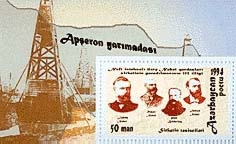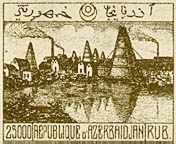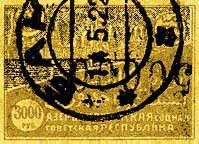|
|
|
|
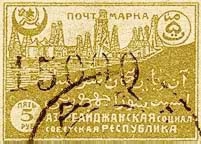 |
|
|
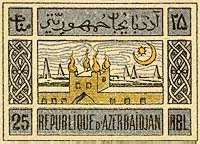 |
Top Left: One of the first Petro-Stamp in the World. It was issued by the Democratic Republic of Azerbaijan and features the Fire Worshippers' Temple near Baku (1919).
Top Right: Overprints on Petrol-stamps during the Soviet period: 15,000 rubles printed over 5 Rubles.
Bottom Left: Overprints on Petrol-stamps during the Soviet period: 50,000 rubles printed over 3,000 Rubles.
Bottom Right: Panoramic view of Bibi-Heybat Oil fields near Baku. Note "Star and Crescent" symbol of Democratic Republic of Azerbaijan. Also note Azerbaijani language in Arabic script and French (1920-21).
The first stamp of the Fire
Temple, depicts five oil derricks in the background and the Turkic
symbol of pointed sun cradled by a crescent moon. French and
the Azeri (Arabic script) were used. At that time the Arabic
script had been in use for hundreds of years in the region although
it would be replaced by Cyrillic in 1929 when the Soviet government
began to standardize the alphabets used in its various Republics.
Panoramic View
of Oilfield
The second Azerbaijani
oil-related stamp (#3) also appeared during this period prior
to Soviet rule. It depicts a panoramic view of an unidentified
oil field. This stamp (with perforated and unperforated editions)
is believed to have been issued privately and is not considered
to be an official government stamp and, therefore, is not cataloged.
Reportedly printed in Vienna, Austria, its origin is unknown.
The Bibi-Heybat
Oil Fields
Soon after the Soviet
takeover in 1920, Azerbaijan as a Socialist Republic issued two
new petro-stamps. One showed a gushing oil well (#4) and the
other a panoramic view of the Bibi-Heybat Oil Fields on the outskirts
of Baku (#5).
Due to the economic disorder and inflation at the outset of the
Soviet rule, the provisional government, instead of issuing new
stamps, continued to use old ones stamped with new values. The
overprints were poorly executed, using primitive printing equipment
and hand-numbering machines with different ink colors.
Two examples are shown: a 5-ruble Bibi-Heybat Oil Field with
a 15,000 rubles surcharge (#6) and a 3,000-ruble Bibi-Heybat
Oil Field, a tête bêche (mirror image), with a 50,000
rubles surcharge (#7).
Twenty-two varieties of overprints have been cataloged of these
first petro-stamps in Azerbaijan. Also, several counterfeit stamps
of the first two were commonly printed and used. The forgeries
can be easily detected today since they were printed on off-white
paper; whereas, the originals were printed on white and, later
in 1921, on brownish paper. There are also slight design differences
which mark the stamps as counterfeit (Varro E. Tyler, Linn's
Stamp News, 1992, 135).
Turkmenistan Also Issues Nobel Stamps
Turkmenistan joined Azerbaijan in commemorating the 115th anniversary of the creation of the Nobel Brothers by producing four petro-stamps and one souvenir set of their own. Their history also is linked to these famous early oil entrepreneurs.
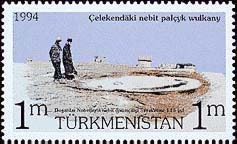
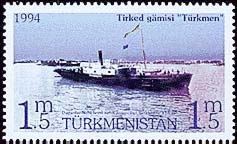
Similar Turkmenistan series also commemorating the 115th Anniversary of the Nobel Brother's Petroleum Company (1994).
When Robert Nobel purchased
his first refinery in Baku, he acquired some land on the Cheleken
Island off the coast of what now is Turkmenistan on the eastern
shore of the Caspian Sea due east of Baku. There, on that isolated
island, Turkomans were involved in the exploitation and mining
of ozocerite, a solid paste mixture of hydrocarbons (mainly paraffin)
of dark-brown color which was sold and used as fuel, lubricant,
and water proofing. The ozocerite was mined by hand by digging
around in some of the active little mounds, known as "mud
volcanoes" which were formed by oil and gas seepage. Turkmenistan's
1-Manat stamp shows one of those "mud volcanoes" (#8).
Since these "mud volcanoes" were familiar indications
of the prolific oil fields in Baku, Robert decided to explore
for oil on the Cheleken Island, too. In the early 1880s he drilled
two wells but the results were poor, he soon gave up exploration.
Several years later, however, Karl Vasiliyevich Hagelin, a manager
of the Nobel Brothers Company, by chance learned about the wells
and in 1901 organized an expedition to study their potential.
As research could be carried out by geologists and engineers
with a better understanding of the oil reservoirs and with more
advanced drilling techniques, it wasn't surprising that oil was
discovered on the island. Turkmenistan's 2-Manat stamp shows
one of the first rigs used to explore the island (#9).
Cheleken Island's crude oil was unusually rich in paraffin. Knowing
that Russia was importing considerable quantities of paraffin,
Hagelin decided to develop and produce this rare type of crude,
and he installed the first paraffin refinery in Russia to process
the crude.
The 1.5 Manat stamp (#10) shows the ship, "Turkmen",
the first of two diesel engine tugs ever built and used in oil
transportation. The "Turkmen" and the "Sart"
were used to pull barges up the Volga River. Both tugs used engines
manufactured by another Nobel company in St. Petersburg.
The 3-Manat stamp (#11) depicts the three Nobel brothers and
Peter Bilderling just as the Azerbaijani stamp does. The 5-Manat
souvenir set shows the Company's 27th Anniversary Commemorative
Medal depicting a cloister of early Baku oil well derricks along
with Ludwig and Robert Nobel.
Hugo Vargas is an Engineer with Chevron in San Ramon,
California, and current President of Petrophil (Petroleum Philatelic
Society International). He proudly displays an original Azerbaijani
"Oil Gusher" stamp of the early 1920s on his office
wall. See the "Opportunities" section in the magazine
for information about Petrophil.
From Azerbaijan International (3.2) Summer 1995.
© Azerbaijan International 1995. All rights reserved.
Back
to Index AI 3.2 (Summer 1995)
AI Home Page
| Magazine
Choice
| Topics
| Store
| Contact
us

